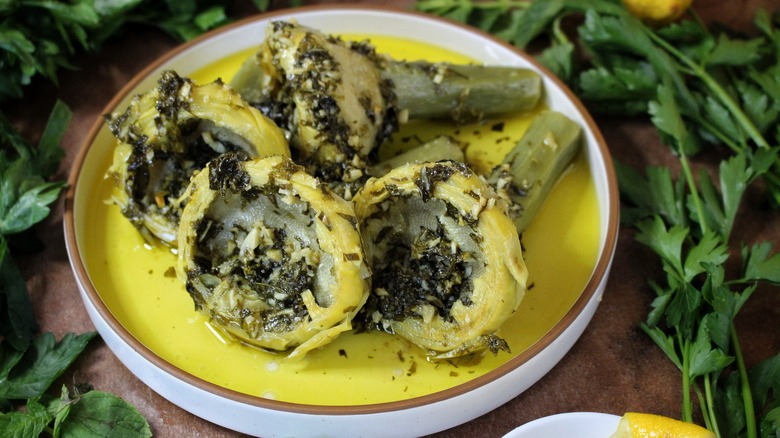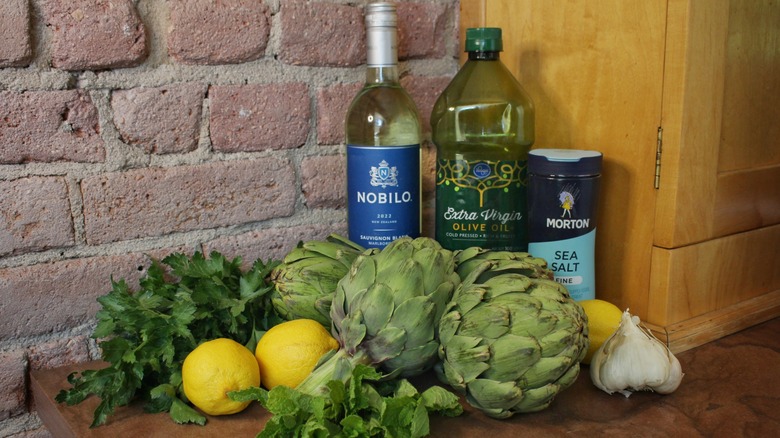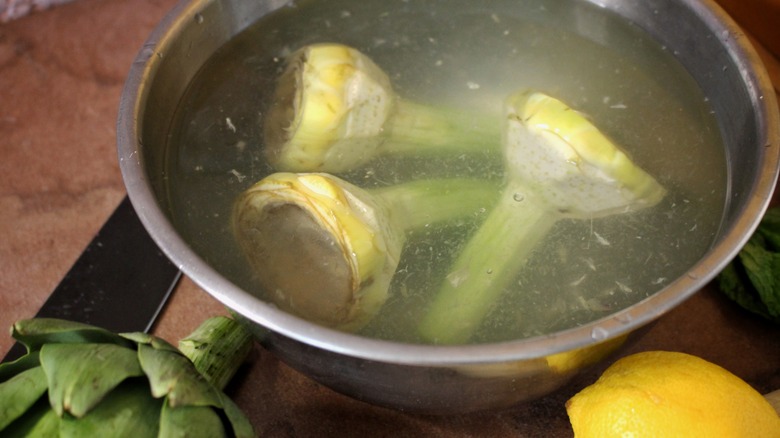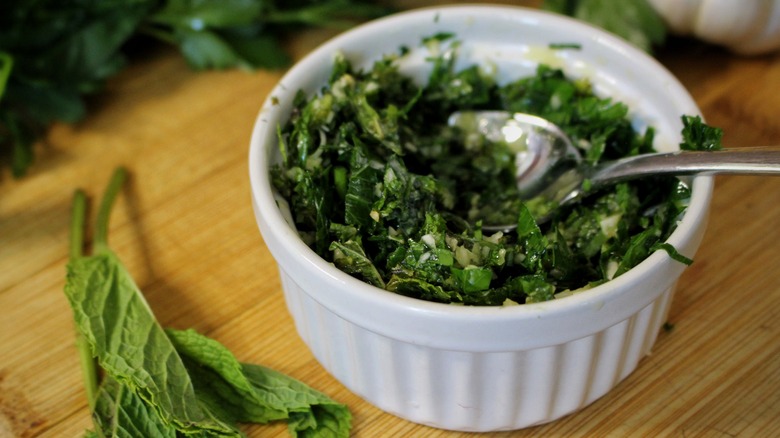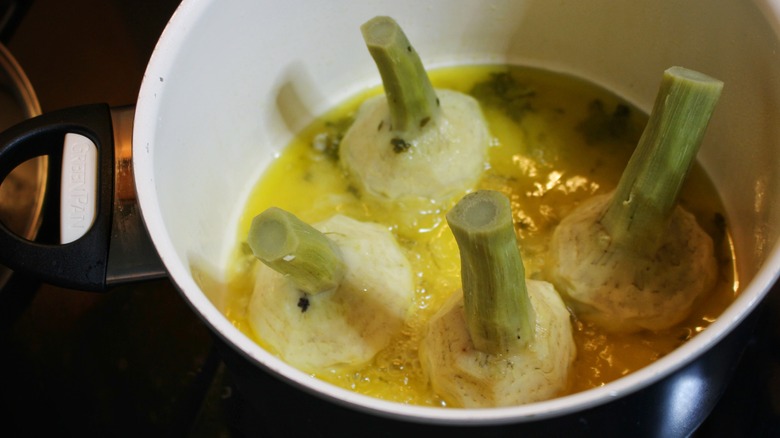Carciofi Alla Romana (Roman-Style Artichokes) Recipe
While some Italian dishes, such as Neapolitan ragù and Sicilian timballo, are complex and elaborate, this classic side dish recipe goes in the opposite direction. "This traditional Roman artichoke preparation," says developer A.J. Forget, "is emblematic of Italian cooking in its reserved approach." After trimming the artichokes (the only time-consuming part of this recipe), all you need to do is stuff them with herbs and braise them. "There aren't any bells and whistles," says Forget, and yet the "delightful" result, he assures us, is "fragrantly herbal and perfectly tender."
While Forget does try to duplicate a traditional Roman-style preparation here, he notes that home cooks may run up against one snag when it came to ingredient availability. If you were to do as the Romans do in Rome, you'd be using an herb called mentuccia (or lesser calamint) for the stuffing, but it's not easily sourced here in the U.S. Instead, this recipe calls for a mixture of mint and parsley. "While it is not exactly the same flavor," Forget admits, he does say that "these two herbs combine to make truly excellent carciofi alla romana."
Collect the ingredients to make carciofi alla romana
The main ingredient in this dish is, no surprise, artichokes. You'll also need a lemon, olive oil, garlic, parsley, mint, white wine, and salt.
Trim the artichokes
For starters, pick out a bowl that's large enough to fit all 4 artichokes (post-trimming, so they'll be a bit smaller than in their current state), then fill it with cold water and squeeze in the juice from half of the lemon. This acidic solution will keep the artichokes from oxidizing (turning brown) once you've prepped them.
Grab an artichoke and pull off the tough outer leaves. Once you see the much paler, softer ones on the interior, you're done pulling. Now, cut off the top portion of the artichoke, about ½ inch above where the choke (or center) starts. Use a small, sharp knife to slice away the tough outer layer of the stem, then trim off the rough base area where the leaves you pulled off were once attached. As a final step, use a spoon to dig out the hairy choke, then pull off any pointy-tipped inner leaves.
Put the trimmed artichoke in the lemon water right away, then give the remaining artichokes the same treatment. Forget cautions that "the trickiest part of this dish is trimming the artichokes," but don't feel too bad if you mess them up, as the long braising time will tenderize them pretty well. Plus, as he points out, "By the time you finish trimming your fourth, you'll be an expert on artichoke anatomy."
Stuff the artichokes
Mix the parsley, mint, and garlic with ¼ cup olive oil. Remove the artichokes from their lemon water bath, then divide the herb mixture between them. Pack the filling down into the hollow centers where you dug out the chokes.
Braise the artichokes
Place all of the stuffed artichokes into a pot with the stems facing up. Turn the stove burner under the pot to medium-low, then pour the water, wine, and remaining olive oil into the pan. Sprinkle the artichokes with a little salt, too. Put a lid on the pot and let the artichokes simmer for 30 minutes or until you can easily stick a fork into them. At this point, remove the lid and keep cooking the artichokes for another 10 minutes to allow some of the liquid to cook off.
When it's time to serve, cut the remaining lemon half into wedges and serve them alongside the cooked artichokes for squeezing. You might also want to sprinkle them with a little more salt, and Forget says a glass of chilled white wine doesn't hurt, either. "These artichokes are excellent both warm and cold," he adds, which means that you can simply refrigerate any leftovers and not have to worry about reheating them when it's time for a second helping.
Carciofi alla Romana (Roman-Style Artichokes) Recipe
Do as the Romans do and stuff your artichokes with garlic and herbs, then braise them until tender.
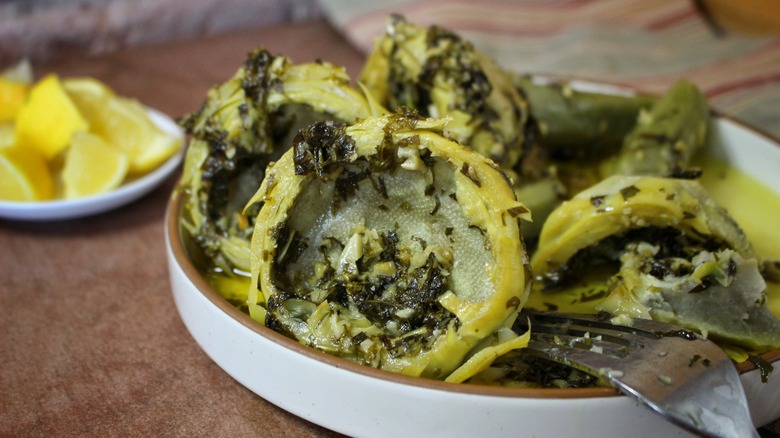
Ingredients
- 1 lemon, divided
- 4 artichokes
- ¼ cup finely chopped parsley
- ¼ cup finely chopped mint
- 4 cloves garlic, minced
- ½ cup olive oil, divided
- 1 cup dry white wine
- 1 cup water
- Salt, to taste
Directions
- Fill a large bowl with cold water and squeeze the juice from ½ of the lemon into it. (You'll soak the trimmed artichokes in this mixture to prevent them from oxidizing.)
- Trim the artichokes 1 at a time. First, pull off the tough outer leaves to expose the paler, softer inner ones. Slice off the top portion of the artichoke, about ½ inch above the choke. Next, slice off the tough outer layer of the stem, and trim the rough base where the leaves were broken off. Scoop out the hairy choke from the center of the artichoke with a spoon and remove any inner leaves with pointy ends.
- Place the trimmed artichoke into the bowl of lemon water and repeat with the remaining 3 artichokes.
- In a small bowl, combine the parsley, mint, garlic, and ¼ cup olive oil.
- Remove the artichokes from the lemon water and divide the herb mixture among them, packing it into the cavities where the chokes used to be.
- Place the stuffed artichokes with the stems facing up into a large pot over medium-low heat.
- Pour the wine, water, and remaining olive oil over the artichokes and season with salt to taste.
- Cover the pot and simmer the artichokes for 30 minutes until fork-tender.
- Remove the lid and simmer the artichokes for an additional 10 minutes to reduce the cooking liquid.
- Cut the remaining lemon into wedges and serve them alongside the artichokes for squeezing, along with additional salt, if desired. The artichokes can be enjoyed hot or cold.
Nutrition
| Calories per Serving | 362 |
| Total Fat | 27.3 g |
| Saturated Fat | 3.8 g |
| Trans Fat | 0.0 g |
| Cholesterol | 0.0 mg |
| Total Carbohydrates | 18.7 g |
| Dietary Fiber | 8.1 g |
| Total Sugars | 2.4 g |
| Sodium | 714.4 mg |
| Protein | 5.0 g |

